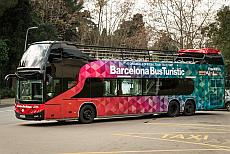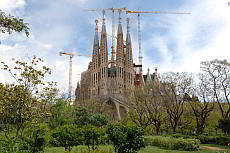Monastery of Sant Pau del Camp
Discover the oldest church in Barcelona
The former Benedictine Monastery of Sant Pau del Camp is Barcelona's oldest preserved church - and a true jewel of Catalan Romanesque.
Content of this page
It was probably built at the end of the 9th century: the founding of the monastery between the years 897 and 911 emerges from the few surviving documents. Gravestones of rich count families indicate that the monastery was very important in its heyday. Today the beautiful complex is a small oasis of peace in the otherwise so turbulent Raval district - and definitely worth a visit.
History of the Sant Pau del Camp monastery
Since the founding of the Roman settlement Barcino in today's Gothic Quarter, there has also been settlement outside the city wall. It was located at the foot of Montjuic on a wide, agriculturally used area called "El Camp".
Highlights of Sant Pau del Camp monastery
- The oldest church in Barcelona
- Wonderfully restored building
- Romanesque architecture with many Gothic and Moorish elements
- Far away of the tourist tracks
There are few and sometimes contradicting documents on the history of the Sant Pau monastery. Based on remains from the Roman-Christian period, it is now assumed that the place was a Christian place of activity even before the Benedictine monastery was built. Traditions from the 5th century show that Saint Paulinus built a hospice here. Documents from 1420 took up these traditions - accordingly Paulinus was buried on the premises of the hospice.
It is certain that the monastery was founded between the years 897 and 911 by Count Guifre-Borell (Wilfredo II.). This is evidenced by the Count's tombstone, which was found in 1596 and which is now on the wall of the left arm of the church building. Wilfredo II died on April 26, 911. He was the son of Wilfredo I el Vellonso ("the hairy one"), who introduced the hereditary nobility in the Spanish Mark in 897 and is considered the founding father of Catalonia.
From the time of its founding to the sacking and destruction by the Moors in 985, there are no written documents about the monastery. It is known that the Benedictines abandoned the monastery before it was sacked by the Moorish troops of Almanzor. Until the second founding of the monastery, more than 100 years later, it remained a simple church, although it did not house a congregation.
The nobles Geribert Guitard and his second wife Rotlendis, founders of the house of Bell Lloc, rebuilt the church building on their own at the end of the 11th century and united it with the monastery of Sant Cugat del Vallés so that a new monastery could be founded. The noble couple placed the monastery under the control of the Holy See in Rome as a donation on April 29, 1117 - but the monastery was still allowed to act independently. In the 13th century, the Sant Pau del Camp monastery was no longer dependent on Sant Cugat. In 1508 Sant Pau was united with the monastery of Montserrat, in 1593 again with Sant Cugat and in 1617 with the monastery of Sant Pere de la Portella del Berguedà.
During the French occupation from 1808 to 1814, the monastery was used as a hospital for the French troops and then converted into a barracks for the Italian troops. In 1835 the Benedictine monks were released from the monastery. The monastery then served as a school and barracks until the church was finally declared a national cultural monument in 1879. Today the restored Romanesque complex is a museum and a cultural venue.
The architecture of the monument
Although the monastery has existed since the 10th century, the current building is the result of extensive renovation and renovation work from the 12th century. Over the centuries, further modifications and extensions were added. As a result, little has been preserved from the original church building. The monastery of Sant Pau del Camp is assigned to the Romanesque, i.e. the pre-Gothic style. But there are also many Gothic elements to be seen.
The monastery church consists of a single nave and the floor plan is based on a Greek cross. The portal, which comes from an older church building from the Visigothic period, is particularly worth seeing. From the simple interior of the church one reaches the beautiful cloister with its multi-pass arches from the 13th century via the Gothic chapter house - it is clearly attributable to Moorish influence and unique in Europe. Inside the church you can see typical Romanesque elements such as windings and barrel vaults.
In the garden is the Casa Abacial, which was completed in the 15th century. The portal is flanked by two marble columns on which the archivolt, the arched semicircular arch, rests. On the tympanum - the decorative surface in the arched area of ââthe portal - Jesus Christ is depicted together with Peter and Paul (Pere i Paul). The pilasters of the pillars on the outside of the church are adorned with human faces, mythical creatures and plants.
The location of Sant Paul del Camp
Raval quarter
The first residents of today's Raval district settled here around 4,000 years ago. This is shown by excavations from 1989 near the monastery, in which, in addition to the remains of a Roman settlement, remains of a settlement from the Bronze Age were found. A year later, when a Civil Guard barracks were demolished, a Neolithic necropolis with 25 graves was found. The area around the monastery housed one of the earliest human settlements in Barcelona.
"El Camp" is the name given to the agricultural area in front of the city walls of Barcelona in the 9th century. At that time the monastery church was located far outside the city, in the open space. Until the Middle Ages, these fields were largely undeveloped. At the end of the 14th century, Raval was finally incorporated into Barcelona. Today, the Raval district, in the southern tip of which the monastery is located, forms the old town together with the Barri Gòtic and El Born districts to the east.
The Sant Pau del Camp monastery is only about 200 meters from the southern end of the Rambla de Raval. The way is signposted.
More interesting facts about Sant Pau monastery
The Spanish mark
The Spanish mark was the politico-military border region between the Moorish Al Andalús and the Franconian Empire. The Moors reached the Iberian Island in 711. After the destruction of Tarragona in 714, Barcelona surrendered and thus escaped destruction by the conquerors. The early Christian basilica on the site of today's cathedral became a mosque. In 801 the Carolingians under Louis the Pious, King of the Franks, recaptured Barcelona from the Moors. In the same year, Emperor Charlemagne founded the Spanish Mark to defend the borders and to recapture all of Catalonia. The rule of the Moors lasted less than 100 years. After the reconquest, the Carolingians installed the Counts of Barcelona. Guifre II introduced the hereditary nobility in Barcelona, which made the counts independent of the Franks. The Moors, militarily weakened, attacked, among other things, the monastery of Sant Pau del Camp, which at that time was not yet within the city walls. After the death of Guifre II, the unity of the Counts of Barcelona broke up. The core, which consisted of the counties of Barcelona, Vic and Girona, remains, however - today's Catalonia developed from this.
Life in the Sant Pau monastery
Little is known about the beginnings of monastic life in Sant Pau. There have only been records since 1229, when the Claustal Tarraconense Congregation was founded. The congregation was an amalgamation of all independent monasteries in Catalonia under the direction of the prior of Sant Pau. According to records, the monastery experienced its heyday in the early 13th century, when a total of at least 10 monks lived there - including a sexton, a person in charge of the monks' clothing and a nurse. Previously, no more than 5 monks had lived there, so that the increase in the monastery made it necessary to expand. The biggest turning point was the merger with the monastery of Sant Pere de la Portella in the 17th century. The monks from this monastery now also moved to Sant Pau, which entailed further renovations. In 1672 the College and the Novitiate of the Congregation were also transferred to Sant Pau. Since then, not only the abbot and the monks have lived on the site, but also "secular" people, including three professors (one for philosophy, two for theology), a librarian, an organist, as well as the monastic students and novices.
Why a visit to the monastery complex is worthwhile
Barcelona's trendy Raval district - known for its multi-cultural and lively hustle and bustle. And right in the middle, like a hidden treasure: Sant Pau del Camp, the oldest preserved church building in the city. Noise and hectic are quickly forgotten during a visit, and on hot days it is pleasantly cool here. You can admire the Romanesque architecture, the many Gothic elements and above all the cloister with its Moorish influences, which is unique in Europe. During a guided tour you will also get a lot of interesting background knowledge about the history of the monastery and the life of the monks within the complex.
With a guided tour to Sant Pau del Camp
(Click on the product images to view prices and availability)
Important information
Surroundings
Find Hotels nearby
Address
Sant Pau, 101
Phone: +34 606 452 806
santpaudelcamp.cat
Arrival
Metro: Paral·lel (L2, L3)
Bus Turístic: Colom - Museu Marítim
Parking nearby
Opening times
Mon. - Sat.: 10.00 - 18.00
Sun. and on holidays no visits
Guided tour: Sun. at 12.45
Admission
Adults: 6,00 €
Guided visit: 10,00 €
Under 12 years: free
Advice on visiting the monastery of Sant Pau
For a visit to the monastery, we recommend planning around 30-45 minutes.
Book your accommodation in Barcelona here! All categories.
1-5*-hotel rooms, apartments, hostels.




